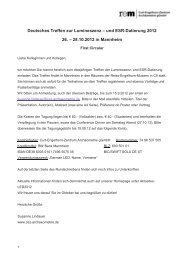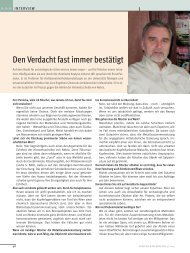Jahresbericht 2010 - Curt-Engelhorn-Zentrum Archäometrie gGmbH
Jahresbericht 2010 - Curt-Engelhorn-Zentrum Archäometrie gGmbH
Jahresbericht 2010 - Curt-Engelhorn-Zentrum Archäometrie gGmbH
Erfolgreiche ePaper selbst erstellen
Machen Sie aus Ihren PDF Publikationen ein blätterbares Flipbook mit unserer einzigartigen Google optimierten e-Paper Software.
Seite 38 <strong>Jahresbericht</strong> <strong>2010</strong><br />
Fig. 1 The Atacama area<br />
in the context of the South<br />
Central Andes<br />
Understanding Precolumbian copper exploitation in northern Chile<br />
through Archaeometallurgical research<br />
Blanca Maldonado, Thilo Rehren, Ernst Pernicka, Lautaro Núñez,<br />
Alexander Leibbrandt<br />
Numerous metal artefacts,<br />
most of them from mortuary<br />
contexts, have been<br />
recovered in the Atacama<br />
Desert of northern Chile<br />
(Figure 1). Nevertheless,<br />
the technological, social<br />
and economic processes<br />
involved in the production<br />
and distribution of these<br />
objects had, until recently,<br />
remained virtually unknown.<br />
Archaeometallurgical<br />
Research<br />
The present work is part of<br />
an ongoing project which<br />
investigates metallurgical<br />
activities in northern Chile<br />
using scientific analysis, as<br />
a first step towards a largescale<br />
map of prehistoric<br />
copper production and<br />
exchange across the South<br />
Central Andes. A first systematic<br />
study of the archaeometallurgy<br />
of copper<br />
in the Atacama region was<br />
initiated in <strong>2010</strong>, as part of<br />
a joint international scientific<br />
project including the<br />
<strong>Curt</strong>-<strong>Engelhorn</strong>-<strong>Zentrum</strong><br />
Archa ometrie (CEZA) in<br />
Germany, the Institute of<br />
Archaeology, University<br />
College London (IoA, UCL),<br />
and the R. P. Gustavo Le<br />
Paige Archaeological Museum<br />
in San Pedro de Atacama<br />
in Chile. The project<br />
was possible due to a fellowship<br />
from the Alexander<br />
von Humboldt Foundation,<br />
and funding provided<br />
by the National Copper<br />
Corporation of Chile<br />
(Codelco). This research<br />
involved documentation<br />
and sampling of already-<br />
The Andes is a rich metallic<br />
ore-bearing region, which,<br />
to this day, provides a variety<br />
of minerals for the production<br />
of gold, silver, copper,<br />
and tin. From the<br />
standpoint of the pre-<br />
Columbian peoples, however,<br />
copper was the most<br />
important metal, and<br />
played a prominent role in<br />
the early metallurgy of the<br />
area. Copper was not only<br />
the predominant metal, but<br />
the most extensively used<br />
base material. Andean metalworkers<br />
produced an<br />
assortment of copperbased<br />
alloys, including copper-arsenic<br />
and tin bronze,<br />
which were fashioned<br />
mainly as ornaments used<br />
in religious ceremonies<br />
and for the enhancement of<br />
elite cultural status.<br />
excavated artefacts from<br />
the Archaeological Museum<br />
in San Pedro de Atacama, as<br />
well collection of copperrich<br />
mineral samples from<br />
different mining locations<br />
in the Atacama region.<br />
Över a thousand metal artefacts<br />
from the Le Paige collection<br />
have been recorded<br />
in the course of two research<br />
seasons, most of<br />
them recovered from burials<br />
at different oasis districts<br />
of San Pedro de Atacama.<br />
Saw-cut samples and<br />
drill shavings were obtained<br />
from 175 of these<br />
objects, considering not<br />
only their category and provenience,<br />
but also their<br />
state of preservation.




